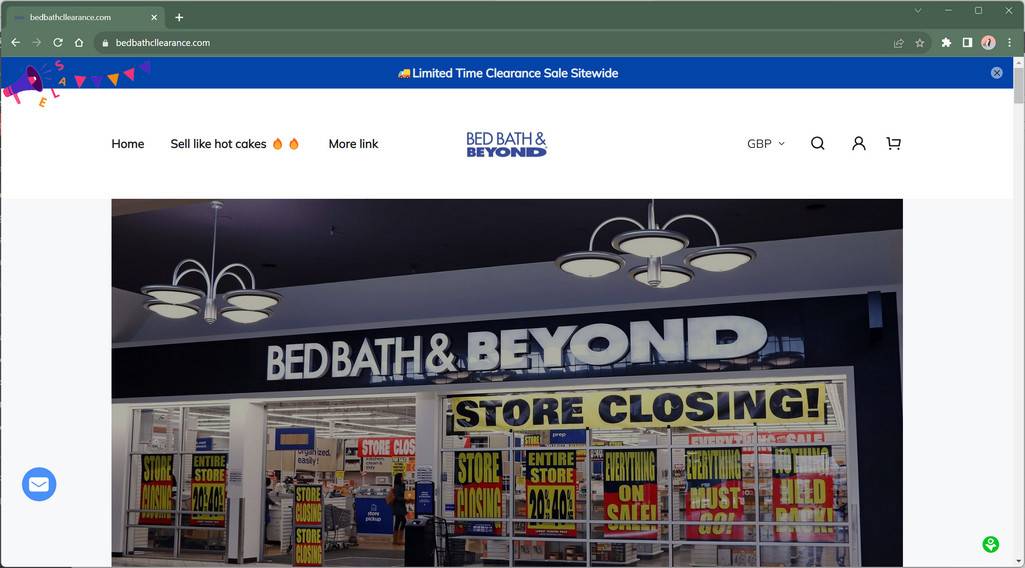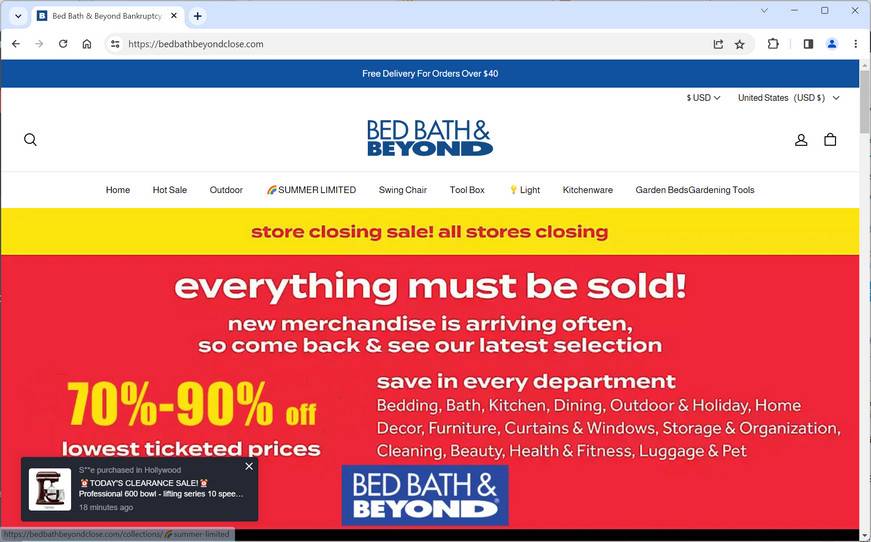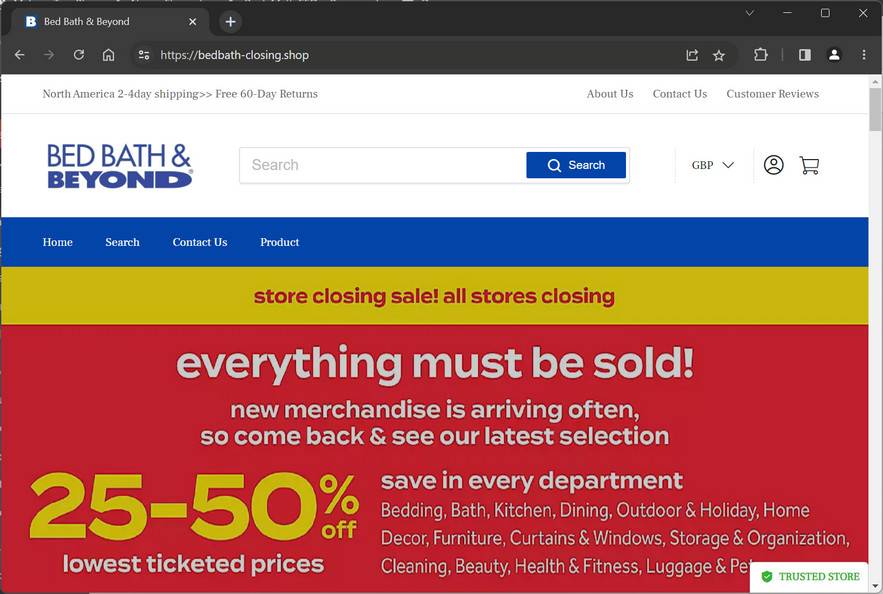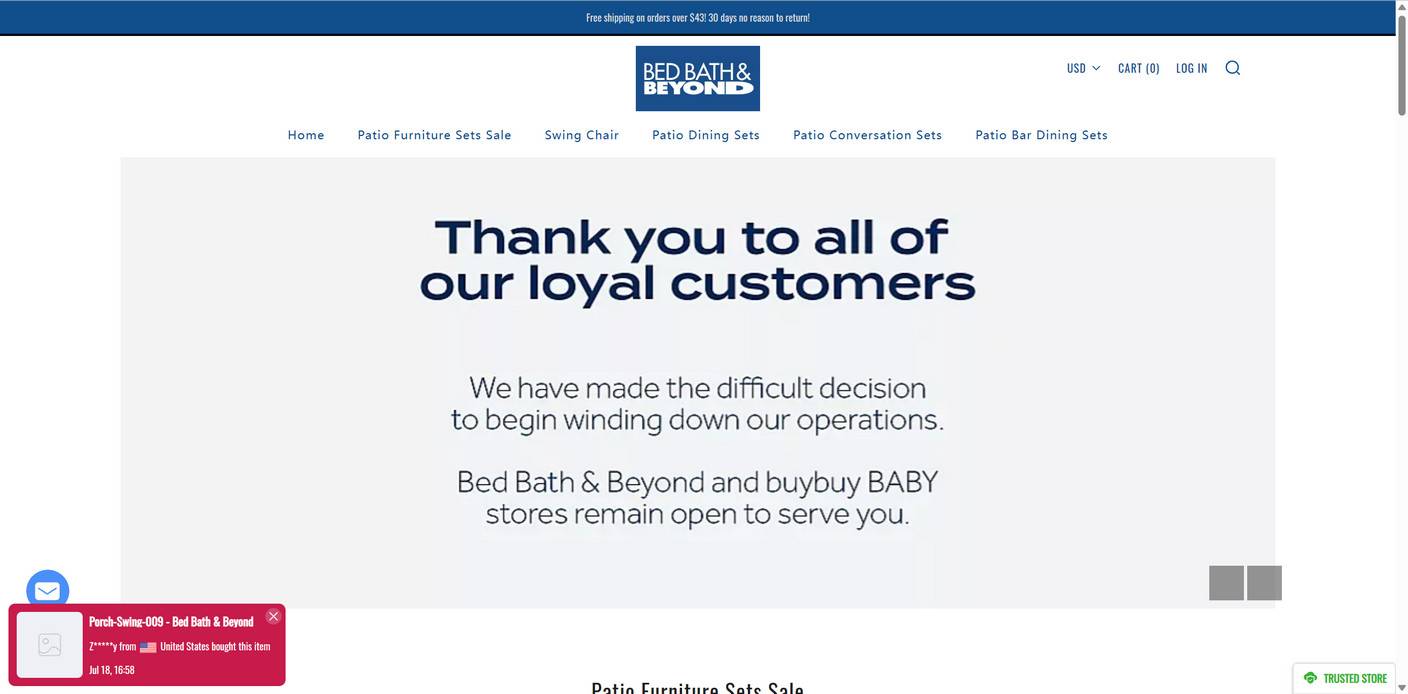Bed Bath & Beyond’s recent bankruptcy filing and store closures have given rise to fraudulent websites falsely claiming to offer huge liquidation sales on Bed Bath & Beyond merchandise. However, shoppers should beware – these too-good-to-be-true “deals” are complete scams aiming to steal your money and information.
Scam Overview
In the wake of news that beloved home goods chain Bed Bath & Beyond will soon begin shuttering its remaining brick-and-mortar stores, scam websites have cropped up posing as the brand and promoting clearance blowout sales of up to 90% off. Through convincing copy and professional-looking design, these sites try to dupe customers into believing they are ordering deeply discounted Bed Bath & Beyond products.
However, unsuspecting shoppers lured in by the promise of rock-bottom prices are caught in an elaborate ruse. These scam websites have no actual relationship with Bed Bath & Beyond. They are not authorized retailers liquidating surplus merchandise. Their only purpose is to defraud customers and pocket ill-gotten payments and personal data.
Research shows this is the work of an interconnected web of scammers based primarily in China. This fraudulent network manages countless fake e-commerce sites that prey on unwitting online shoppers. When a well-known brand like Bed Bath & Beyond announces major changes, scammers quickly capitalize by creating convincing impersonator sites.
The scam sites targeting Bed Bath & Beyond shoppers exhibit all the textbook signs of an online retail fraud. Plagiarized legal pages, lack of contact information, unbelievable discounts up to 90% off, and absolutely zero social media presence or signs of transparency about who owns the business.
Unsurprisingly, those who place orders through these websites are left completely ripped off. Most never receive any products at all, defrauded of their payments. For the few who do get packages, the items are shoddy knock-offs or used goods – nothing like what was described online.
By steering clear of these Bed Bath & Beyond clearance sale scams, you can avoid losing your money or having your personal and financial data stolen. Be vigilant and exercise caution before providing any information to e-commerce websites you don’t recognize.
How the Scam Works
The fake Bed Bath & Beyond liquidation websites operate through a straightforward scam formula designed to quickly separate victims from their money. Here is how they work:
1. Scam Ads Lure Customers In
The first point of contact for most victims is a digital ad promoting a too-good-to-be-true clearance sale on Bed Bath & Beyond merchandise. These flashy ads are most commonly found on social platforms like Facebook, Instagram and TikTok.
The ads tout closing down sales with extreme discounts between 70-90% storewide. Bold statements like “Entire Store On Sale!” and “Nothing Held Back” aim to convey huge savings opportunities. The ads are formatted to strongly resemble legitimate Bed Bath & Beyond promotions.
2. Shoppers Land on Elaborate Scam Websites
Clicking these ads leads customers not to BedBathandBeyond.com but instead to sophisticated scam websites dressed up to look like authorized online Bed Bath & Beyond retailers.
These fraudulent sites go to great lengths to appear trustworthy, featuring Bed Bath & Beyond’s actual branding, images and logos. Their product listings are ripped straight from the real company’s website and catalogs. The sites even mimic Bed Bath & Beyond’s web layout, fonts, colors and text.
In reality, they have zero affiliation with the brand. They are Potemkin village-like imitations purely meant to trick visitors.
3. Scam Sites Offer Unbelievably Low Prices
A defining feature of these fraudulent Bed Bath & Beyond websites is absurdly low prices, even on bestselling items. Popular products like air fryers or luxury sheets are advertised at 70-90% off regular prices – often $100+ discounts.
These unrealistic markdowns are dangled to overcome skepticism and entice victims to place orders. The scam sites also employ other pressure tactics, like countdown timers, claims of limited stock and notifications that items are selling out fast.
4. Shoppers Check Out with Personal and Payment Details
During checkout on the scam websites, unsuspecting customers enter their name, shipping address, email, phone number and payment information.
The sites request all this data under the guise it is needed to process orders and calculate shipping costs. In reality, it is collected so scammers can steal identities and commit payment fraud.
Victims checkout believing they are dealing with the real Bed Bath & Beyond and entering payment details through a secure process. But in truth, they are handing over sensitive personal and financial information directly to criminals.
5. No Orders Ship Out After Payments are Processed
After completing checkout and payments, excited customers await shipment of the deeply discounted Bed Bath & Beyond products they purchased.
But the reality soon sets in – no order confirmations or tracking numbers ever arrive. Multiple follow-ups and complaints yield no responses from the scam websites.
The sites go totally dark after payments are processed. Customers are left empty-handed, ripped off without receiving any merchandise.
In rare cases, victims eventually receive packages with cheap counterfeit goods or used items clearly not from Bed Bath & Beyond. Either way, they are left totally fleeced by the scam sites.
6. Scammers Disappear with Payments and Personal Data
Throughout the entire process, the individuals behind these websites give zero truthful information about who they are or where they operate. They hide behind the veil of a sophisticated scam site.
After they’ve extracted victims’ money and sensitive personal data, the scammers vanish without a trace. They shut down websites and disappear, only to reopen under new scam sites posing as other brands.
They then compile stolen information to commit identity theft or resell on the dark web. The payments they collect fund the perpetuation of their criminal enterprise.
This network of scammers based in China manages an untold number of fake retailer websites to continually scam unwitting shoppers. They remain at large internationally by staying several steps ahead of authorities.
What to do if you have fallen victim
If you believe you may have fallen prey to a scam website impersonating the Bed Bath & Beyond clearance sale or another retailer, here are important steps to take right away:
- Contact your bank or credit card provider: Alert your financial institutions that you provided your payment information to a suspected fraudulent website. They may be able to stop payments from being processed. Contact them about possible refunds and dispute resolution processes.
- Place fraud alerts: Notify credit bureaus to place fraud alerts on your credit reports. This protects you from scammers trying to open new fraudulent accounts in your name.
- Monitor your accounts: Keep close watch on all your financial accounts for any suspicious, unauthorized or fraudulent activity. Report anything strange you notice.
- Change account passwords: Change login passwords on all your online accounts, especially financial accounts and email. Use strong, unique passwords for enhanced security.
- Beware of phishing scams: Scammers may send scam emails claiming there is an issue with your “order” to try gaining passwords and sensitive info. Ignore these phishing emails.
- Document details: Note any details about the scam website, order and payment methods used. This creates a record that may help during investigation and recovery.
- Report the website: Report the scam website to the hosting provider, registrar, FTC and IC3 to help get it taken down and prevent further victims.
- Seek other potential recourse: Depending on where and how payments were processed, you may be able to work with payment providers to halt transfers or request refunds through fraud protection programs.
- Be extra vigilant moving forward: Stay alert about sharing any sensitive information online to avoid being victimized again. Research unfamiliar sites thoroughly first.
By reporting fraudulent sites and diligently monitoring your accounts, you can limit the fallout from providing payment information to a scam. But prevention is always best – be cautious when sites promote deals that seem too good to be true.
How to Spot the Bed Bath & Beyond Clearance Sale Scam
It can be tricky to tell legitimate deals apart from sophisticated scams. Here are tips for identifying fraudulent websites falsely claiming to offer huge Bed Bath & Beyond savings:
- Look for unbelievable discounts – Authentic retailers rarely offer more than 50% off at maximum. Discounts above 70% or 90% off are almost always scams.
- Research unfamiliar sites – Search the site name plus terms like “scam,” “fake,” or “review” to uncover complaints. Look for contact info, ownership details, and authenticity signs.
- Verify secure checkout – Real sites encrypt connections and URLs begin with “https.” Info entered through unsecured checkout will be stolen.
- Watch for pressure tactics – Scam sites often use countdown timers, low stock warnings, or other tricks urging you to buy fast before “deals” disappear.
- Inspect site carefully – Look for grammatical errors, inconsistent formatting, and other sloppy mistakes common on scam sites.
- Reverse image search – Searching product images often reveals they’re stolen from authorized sites, a clear scam indicator.
- Compare to real site – The legitimate Bed Bath & Beyond site is BedBathandBeyond.com. Fakes try mimicking it but have subtle differences.
- Beware of social media ads – Scam sites rely on Facebook/Instagram ads and influencer posts rather than organic traffic.
- Trust your instincts – If a deal seems questionable, walk away. It’s better to miss a deal than lose money on a scam.
Carefully scrutinizing sites and applying skepticism before providing information can prevent being scammed. If it seems too good to be true, proceed with extreme caution.
Scam FAQ
Here are answers to some frequently asked questions about the Bed Bath & Beyond clearance scam and other online shopping scams:
Who is behind these scam websites?
Research indicates this scam network traces back to groups based primarily in China that create fraudulent sites posing as legitimate Western retailers. They go to great lengths to conceal their true identities.
How do they make the sites look real?
Scammers plagiarize copyrighted content, images and branding from authentic retailers to make their sites look convincing. They also mimic page layouts, color schemes and website text.
Why are the prices so low?
Extreme discounts like 90% off are meant to get shoppers to abandon common sense. If a deal seems too good to be true, it almost always is.
What do they do with my payment info?
Scammers use stolen payment card details to try making fraudulent purchases or reselling the data on the black market. They may also use it to commit identity theft.
What do I receive if I order from these scam sites?
Most customers receive nothing. In some cases, victims receive cheap knockoffs or used/damaged goods clearly not what was advertised. The sites never ship actual products from real brands.
Can I get my money back if I paid by credit card?
If you contact your credit card provider quickly, they may be able to halt payments or issue refunds. Each bank has specific policies, but acting fast maximizes your chances.
Is there anywhere else I should report these scam sites?
Reporting them to hosting providers, registrars, the FTC, and IC3 helps get them taken down faster. The more reports against a site, the quicker it will be shut down.
How can I identify scam websites in the future?
Look for red flags like no contact info, hidden owners, unbelievable prices, grammatical errors, threatening language, lack of encryption, and zero social media presence.
What can I do to avoid online shopping scams?
Stick to large, well-known retailers. Search for reviews. Beware of ads promoting deals that seem too good to be true. When in doubt, trust your instincts – if it seems sketchy, it probably is.
Are the websites violating any laws?
Yes, these scams violate trademark laws by misusing brands’ names, logos and imagery without authorization. They also break laws against false advertising, fraud and identity theft. However, laws are not often effective deterrents when scammers operate abroad.
Is Bed Bath & Beyond affiliated with these websites?
No. Bed Bath & Beyond has no relationship with these unauthorized scam websites falsely claiming to sell their products at clearance prices. Bed Bath & Beyond only sells through BedBathandBeyond.com and authorized retail partners.
Why hasn’t Bed Bath & Beyond gotten these sites shut down?
While brands try their best to combat online counterfeits and scams, the sheer volume makes it difficult. Scammers are adept at evading detection through technical tricks and constantly creating new sites.
Conclusion
During times of major retail changes like closures or bankruptcies, consumers should be on high alert for scam websites aiming to exploit the situation. Too-good-to-be-true clearance sales on struggling brands like Bed Bath & Beyond are almost guaranteed frauds.
These sophisticated scam sites only want your money and data. By pretending to sell liquidated merchandise at drastic markdowns, they trick unsuspecting shoppers into handing over their personal and financial information.
Once payments are processed, scammers disappear without fulfilling any orders. At best, victims receive shoddy counterfeit products clearly not from the genuine retailer. More often, they are left empty-handed.
While scam websites go to great lengths to appear real, telltale signs like unbelievable prices, stolen images, and lack of contact info reveal their fraudulent nature. Avoid becoming another victim by exerting caution when sites promote deals that seem too good to be true. Only make purchases through authorized retailers you recognize and trust.
















